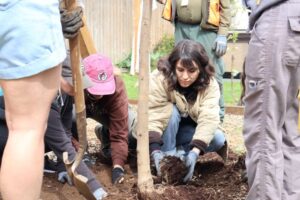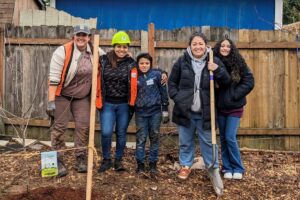Tag: education
A Community Forest for the Future
How trees and community can work together in the face of climate change
If you go to Nadaka Nature Park in Gresham, you’ll see plenty of trees. It’s an oasis of shade in East Multnomah County, where many neighborhoods don’t have much shade tree canopy. In June 2021, when the Pacific Northwest was embroiled in a heat dome effect, 72 people died in East Multnomah County. We’ve learned the hardest possible way just how valuable shade can be.
For a lot of people, the Pacific Northwest conjures images of cool, rainy weather and towering trees. They might think of something like Nadaka Nature Park. But many urban neighborhoods in the Pacific Northwest qualify as heat islands, where limited greenery and heat retained by buildings and roads create higher-than-normal temperatures. Even if the heat dome was a rare extreme, climate change is bringing record summer temperatures, and low-canopy neighborhoods are in desperate need of the cooling power of shade trees.
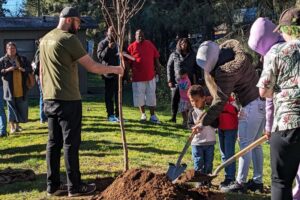
On March 16th, dozens of volunteers gathered at Nadaka on an especially gorgeous morning, eager to plant trees in the surrounding neighborhoods. All of these new trees serve as a memorial to the lives lost to the 2021 Heat Dome and once they’ve matured, they’ll cast shade on homes and sidewalks for decades to come.
“The 2021 heat dome brought us into stark understanding of the vulnerabilities of our neighborhoods, where the shade of trees is a precious resource,” says Yashar Vasef, Executive Director for Friends of Trees.
It’s been nearly three years since that historic heat wave with temperatures as high as 119 degrees Fahrenheit, but for some the memory is still particularly fresh. Several families who lost loved ones during the heat dome joined the volunteers at Nadaka to mark the occasion with intentionality and reflect on the purpose of the planting event. The morning was not a somber one, because, as Multnomah County Chair Jessica Vega Pederson put it in her remarks, “planting a tree is a hopeful act.”
In addition to the trees planted throughout the community that day, there’s a new tree at Nadaka, an American hornbeam planted by the families. Before they filled in the hole, the families added hearts to the soil with the names of those they lost. One family member said they plan to return to the park each year for a family barbecue and to visit and care for the memorial tree.
“This is what it means to grow a community forest,” Yashar says. “Yes, it’s planting trees and creating green spaces where they’re needed most, but it also means getting community members involved. We can build relationships, share knowledge and resources. We can work together to make sure everyone has access to the benefits of trees.”
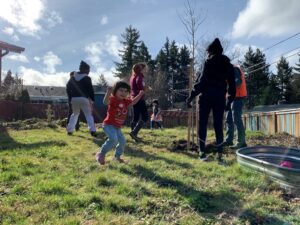
In the face of a changing climate, trees and green spaces improve our lives
If you’ve ever gone for a walk or a jog on a warm sunny day, you might find yourself chasing shade. It’s intuitive that shade is cooler than full sun. But how much cooler? Studies have shown that trees can lower urban temperatures as much as 10 degrees. During a heat wave, that can be lifesaving. The heat dome served as a stark reminder that weather can have a real and devastating impact on people.
Extreme heat is becoming more common, even expected, during summers in the Pacific Northwest. Homes without shade trees will be significantly warmer and will need to rely more on air conditioning during summer months.
“Communities at this higher latitude are arguably the most underprepared for these kinds of events,” Portland State University Professor Vivek Shandas said. “We saw that really bear down on us in 2021.”
The cooling power of shade is a cost-effective way to cool our homes, parks, and sidewalks. We need to preserve the canopy we have, and continue to grow it. New mapping from Multnomah County shows how trees and the built environment impacts temperature.
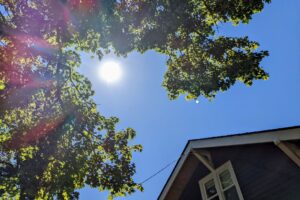
“Not everyone has access to trees and green spaces, which means that they don’t have access to their benefits,” Yashar says. “If we want to grow a true community forest, we need to work to expand that access and plant trees in the most vulnerable communities.”
Beyond cooling, trees have so many benefits. They remove carbon dioxide from the atmosphere and use it to grow, storing carbon that would otherwise contribute to climate change. The more a tree grows, the more carbon it stores. During one year, a mature tree can absorb 48 pounds of carbon dioxide from the atmosphere and release oxygen in exchange.
Even in urban settings, trees provide habitat for wildlife. Take one of our favorites, the oak tree. “You plant an oak in your yard, you’re planting a zoo,” says Douglas W. Tallamy, author of The Nature of Oaks. “It’s your chance to create life that didn’t exist in that space.”
Trees clean our air. Trees improve air quality by providing surface area for airborne particulates to stick to. Those particulates are then washed by rain into the soil, where microorganisms break them down into something less harmful.
Our Clean Air Canopy project is the result of an Oregon Department of Environmental Quality lawsuit against a polluter in the neighborhood. The DEQ fined the facility and granted funds to Friends of Trees and our partners to lead community tree plantings in the area.
That sentiment was shared among volunteers at Clean Air Canopy planting events in Northeast Portland, who were grateful to turn this negative —pollution—into a positive thing for their neighborhood.
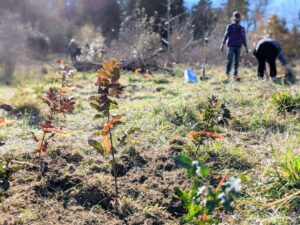
Green Space volunteers feel the same way when they plant in natural areas along streams, because trees and green spaces clean our water, a resource that’s becoming more and more precious. Almost all of our natural area plantings take place alongside a stream. Take the Wilkes Creek Headwaters in outer East Portland. The 20.7-acre hybrid park is nestled in the neighborhood, and provides opportunities for local residents to connect with nature.
The natural area is particularly special because it is home to the headwaters of Wilkes Creek, which flows into the Columbia Slough. Just past the planting site, you can see the natural springs where water comes to the surface and turns into a stream.
“Wilkes Creek is one of the only remaining free-flowing above-ground streams that makes its way into the Columbia Slough,” says Yoko Silk, a Stewardship Coordinator with PP&R. “There used to be hundreds, now there’s only a handful. So it’s really special for being that source of cold, clean water into the slough.”
With all of these benefits, trees and green spaces are an incredibly cost-effective way to improve lives in our communities, regardless of the changing climate. Dr. Geoffrey Donovan, a researcher with the United States Forest Service, wanted to investigate one step further — do trees save lives?
Luckily, Donovan had access to years worth of tree planting data from Friends of Trees. Specifically, he used the planting data from the nearly 50,000 trees that Friends of Trees planted in Portland neighborhoods since 1990.
The study, published in December 2022 in the journal Environmental International, found that each tree planted was associated with significant reductions in non-accidental and cardiovascular mortality. To account for other possible explanations for the mortality rate like race, education, and income, the statistical models incorporated data from the American Community Survey.
As the trees mature, their benefit grows too. Trees planted within the past 11-15 years had twice the impact of trees planted within the last five. The study stops short of proving a definitive causal relationship between planting trees and fewer deaths, but Donovan expressed confidence in his findings, saying, “we do think it’s likely that trees are saving lives in Portland, because we accounted for a lot of other explanations.”
The study went on to associate the reduced death rate with an incredible economic benefit, based on the EPA’s statistical value of a human life.
“In short, trees are cheap and human lives are valuable,” Donovan says.

Picking the right trees for the future
When it comes to trees, there are so many layers to preparedness, from the near to distant future, from the next heat wave or ice storm to what the climate might look like in 25 years. So much of the future is uncertain, but there’s plenty you can do to prepare your trees for what they might encounter.
“So much is unknowable,” says Eugene Director Erik Burke. “You won’t have the information you need to make your decisions when you make them. You just have to make your best guess.”
It starts with planting the right tree in the right place. Sometimes people favor certain species because of sentiment or aesthetic appeal, but if they aren’t planted in a place with the right conditions, they’re more prone to failure. Selecting a tree for the available space, light and soil type is the first step. Considering trees that are adapted to your climate, and what the climate might be in the future, can set your tree up for a long, healthy life.
“People think about what they want in a tree but it might not be a good fit for their property,” says Litzy Venturi, the Community Tree Care Coordinator at Friends of Trees.
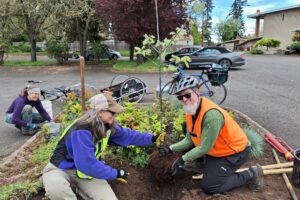
The urban environment presents unique challenges to trees that would otherwise do well in a forest. Concrete and asphalt trap both heat and cold. The soil is often stripped of top soil and compacted. And trees are usually stranding alone, rather than part of a multilayered forest ecosystem.
Climate change only complicates the right tree, right place concept that is at the core of our planting program. Urban spaces are also usually a degree or two warmer than natural areas, which is only made worse by climate change. Some local species, like the western red cedar, are already struggling due to warmer temperatures.
With the climate changing, and potentially dramatically, it makes sense to consider non-native trees that would do well here, especially if they’re drought-tolerant and free of pests and disease.
“For a while, the estimate was that by 2050, Eugene’s climate might be like Sacramento’s is now,” Erik says. “But that estimate is moving even further south to Stockton.”
Erik outlines three approaches that planting programs can take to prepare for climate change. The first is diversity for diversity’s sake. Planting a variety of trees means that if any particular species fails due to climate impacts or disease, it won’t take out a huge chunk of the urban forest. The second is very intentionally looking at trees adapted to our native climate and soils, but many of those species aren’t readily available in the nursery trade. The third is planting broadly adapted trees with huge ranges, but many of those trees aren’t drought tolerant, and because many of those trees are clones, they aren’t given the opportunity to adapt from generation to generation.
“Really, we should do some of each approach,” Erik says. “There are trade-offs for each.”

We must care for trees so that they can care for us
We want trees to not just survive, but thrive. When we think about trees and native plants thriving in the urban environment—and in the face of climate change—we need to think in terms of tolerance.
“Trees can tolerate all sorts of conditions but can they really thrive to their maximum potential size and lifespan?” Litzy says. “Trees are incredible at surviving but they might just be limping along.”
Some trees are more tolerant of pollution, for example, and are good choices to be planted alongside busy roadways. Beyond tolerant, some trees are particularly good at removing particulate from the air. These are the factors we need to consider when making choices about selection. For trees with lower tolerances, that pollution will add stress to the tree that will prevent it from fully thriving.
So many things can put stress on a tree. It’s up to us to mitigate those stressors wherever we can. Some of that can be done when we select the right trees for the right place. But there is still more that we can do for a tree after its planted, especially during its establishment years.
“It’s important to remember that stress is additive,” Erik says. “Even if a tree survives, stress can pile up from heat wave to ice storm to heat wave. That’s why we need to water during heat waves and prune properly after ice storms.”
While heat waves and ice storms are beyond our control, our response to a storm is the first step in preparing for the next one. Erik warns that bad pruning after an ice or wind storm can lead to more failure down the line, because limbs won’t be strong enough for the next. Still, he advocates for proper pruning after storm damage rather than removing a tree.
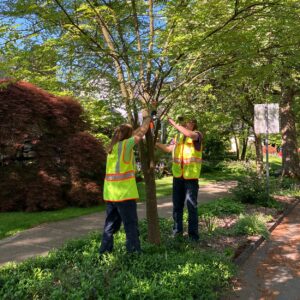
“When you remove a tree, you’re back to square one,” Erik says. “But restorative pruning can give that mature tree a chance to continue providing benefits.”
The more stress a tree has, the more susceptible it is to pests and disease. We’ve had two new pests arrive in Oregon in recent years—the emerald ash borer and Mediterranean oak borer.
“With climate change, we might have to be even more prepared to support trees with water and mulch,” Litzy says. “That extra level of care might help the tree thrive and be able to stave off pests and disease. And even when we plan to water, we don’t want to plant trees that need a lot of water.”
As we see shorter rainy seasons and longer dry seasons, watering becomes an important calculus. Water is critical for photosynthesis—trees need it for food. We may even reach the point where native plants will need water support after establishment.
“It’s so important that we plant in the right conditions and provide care,” Litzy says. “I like to think of healthcare for people. You do preventative care whenever you can, and respond to issues when they arise.”
Selection, tree care, and public education. This is how we reach what Erik calls our ultimate goal: to have a healthy relationship with trees. That’s why it’s important to find opportunities to talk about trees.
“Weather and climate is something everyone experiences,” says Taylor Glass, Eugene-Springfield Program Manager. “It’s something to connect over. It’s a way to talk about climate change.”
“My hope is that it will cause us to cooperate more,” Erik says.
“We’re going to have to,” Taylor says.
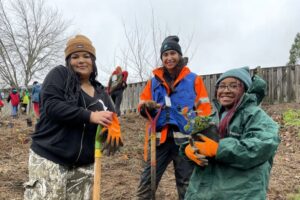
Creating the next generation of climate champions
Last October, a group of high schoolers from the Cascade Education Corps led three classes from CF Tigard Elementary in a natural area planting at Woodard Park. Before the students got to plant, our Green Space Specialist Kaitie Benedek asked the elementary schoolers a simple—and big—question: “Why are we here today?”
The kids were quick to answer. “Climate change!” “Oxygen” “Food for animals!” “To plant more trees than we take down.”
Already, these kids are becoming the next generation of environmental stewards. They recognize the benefits of trees and green spaces, from fighting climate change and providing habitat to cleaning our air and water. And they wanted to maximize their impact by planting as much as they could in a single class period.
“We’d have classes of 25 at a time planting for one class period, so it was super fast,” Kaitie says. “So many kids got excited about planting, and about getting to contribute to this park right by their school. A lot of the kids even named their plants.”
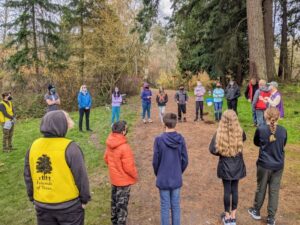
Students from Cascade Education Corps (CEC) helped lead the plantings. CEC members are high school students following an alternative path to graduation by working on hands-on environmental projects. With elementary, middle and high schoolers working together and people walking by in the park offering encouragement, the plantings at Dirksen and Woodard had a wonderful intergenerational feel to them.
“When you get students involved in learning about the environment, appreciating the place and engaging with it, they’ll take those lessons home and share them,” says Green Space Specialist Meng Vue.
Recently, the latest cohort of Friends of Trees’ Adult Urban Forestry and Restoration Training Program finished its 10-week curriculum and moved into their internship phase. The program is designed to increase career opportunities for underrepresented communities in the urban forestry and natural area restoration fields. Many of those participants come to Friends of Trees through Connecting Canopies, which offers a 9-month training in urban forestry and restoration to BIPOC young adults. Their time with Friends of Trees is one piece of that training, focused on a community approach to planting trees.
“When people work in the forestry or restoration field, their skills and knowledge trickle down into their community,” says Theresa Huang, Partnerships & Planning Manager at the Urban Greenspaces Institute.
Cata Krznarich participated in the program last year. Their pursuit of a career in the environmental realm is rooted in the idea of reconnection.
“Growing up in California in the woods, I had the access and privilege to be a natural space,” Cata says. “When I moved into the city, I felt like I was pushed out of my home and way of living. I went to school for environmental science and I’ve done a lot of internships to get back to nature and that sense of home.”
Cata joined the Connecting Canopies and Adult Urban Forestry programs to find career pathways into the environmental field. By meeting people who work in the field, they were exposed to real world possibilities. For Cata, it’s important to focus on putting a real dent in climate change, an issue that for many can feel too big and abstract to tackle.
“Climate change is really front and center in my mind,” they say. “It comes to mind first thing every morning with my first cup of coffee. I do try to read a lot of positive climate justice news because the negative stuff can be very daunting and very scary. And then I finish my coffee and get to work to put a little dent.”
Cata can always find reasons to be hopeful—like when “seeing flowers come up where I don’t expect.” Community, too, brings them hope. Being part of the Connecting Canopies cohort helped them see the impact that a group of people can have when they work together.
“Working with my cohort, when everyone has that same passion, it can feel like more than a dent when we plant 50 ponderosa pine trees on a rainy day.”
For Cata, our relationship with the land is intricately related to climate change, and reconnection to the land provides a path forward. Their next internship is with Elderberry Wisdom Farm, where they’ll learn more about Traditional Ecological Knowledge, habitat restoration, and climate justice.
“Something that brings me hope is seeing native people getting their land back, that restoration and healing. I’m always asking, how can we heal? Putting our hands in the ground and our feet back in the ground will help us all reconnect and understand our own impact”
A community forest built by community climate action
This year, an 11-member coalition led by Friends of Trees is putting into action a $12 million Urban and Community Forestry Grant from the U.S. Department of Agriculture, part of the Inflation Reduction Act (IRA) grants. The grant will fund the engagement of low canopy neighborhoods included in the Biden-Harris Administration’s Justice40 initiative, which will bring resources to communities most impacted by climate change, pollution, and environmental hazards.
The driving theme of the IRA Project is coalition building.
Coalition building goes hand-in-hand with Friends of Trees’ mission to grow community by planting and caring for trees and natural areas together. While we are proud of our past and existing partnerships, this new project is an unprecedented opportunity to take our approach to partnering to the next level by more meaningfully and responsively collaborating with community stakeholders. This includes carving the time and capacity to connect as project partners and people.
Partners like POIC are working to create the next generation of environmental stewards by connecting high school youth with career training. They’re regular crew leaders at Friends of Trees planting events, and the coalition grant will help support their work.
Depave will help communities transform over-paved spaces into urban greenery. APANO, another coalition partner, is finding ways to connect with community members in the project area.
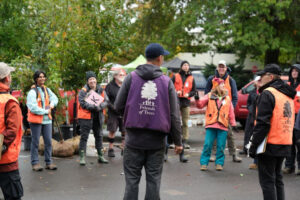
“When have we ever had 11 different organizations coming together as one coalition for a cohesive goal? It’s really awesome,” says Alisa Kajikawa, APANO’s Community Development Manager for the Jade District. “Hopefully this is a case study for the future, showing what happens when we stop working in silos and work toward a shared goal in different ways.”
This coalition grant is just one investment in growing a community forest, one that will hopefully set a blueprint for the transformational climate action we urgently need.
A community forest is a lot of things. It’s the trees, plants, and animals that live in our neighborhoods. It’s the way they contribute to the environment by cleaning air and water, creating habitat, and fighting climate change.
And it’s us. How we work together to build an equitable urban forest, where everyone has access to trees and green spaces. How we take care of that urban forest as the valuable resource that it is. How we foster an ethic of stewardship for people and urban nature alike.
“These times in our world are troubled and the news is often grim; each time I participate in a Green Space planting I receive a huge dose of hopefulness.”
-Anonymous volunteer
From Eugene to Vancouver, when volunteers show up to a planting event and put their hands in the earth, they’re taking real climate action. When thousands of volunteers take climate action, they’re growing a community forest, one that will support us into the future, no matter how uncertain.
Partner Spotlight: POIC
POIC is part of the 11-member coalition for our IRA Community Forestry Grant
On a sunny Saturday morning at Gateway Green Park, volunteers gathered to plant native plants on the wooded hillside of the park. Many of the volunteer crews were led by quiet but capable young folks from POIC.
Portland Opportunities Industrialization Center (POIC) connects high school youth with career training, including partnering with Friends of Trees. POIC students train as crew leaders and lead Friends of Trees plantings throughout the season. Gateway Green was this cohort’s fifth event overall this season, and second as crew leaders.
“This season is going great,” says Leigh Rappaport, Program Manager for POIC’s Natural Resource Pathway. “They’re a really committed group. They care about what they’re doing and are thoughtful about making sure volunteers are having a good time.”
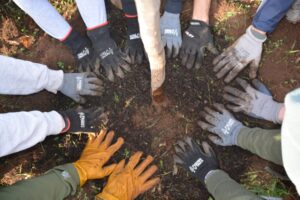
POIC is part of the 11-member coalition led by Friends of Trees that was awarded a $12 million Urban and Community Forestry Grant from the U.S. Department of Agriculture as part of the Inflation Reduction Act grants. The grant will fund community forestry work including tree planting, natural area restoration, post-planting care, community education, opportunities for direct community input and participation, and workforce training.
Part of the grant will help fund POIC’s natural resource training for five years. “Having this funding gives us room to breathe” Leigh says. “We can really focus on the program.”
Beyond that, Leigh looks forward to all of the partnerships that will grow out of this expansive and collaborative project.
“We’re excited to be part of a coalition being built from the ground up.”
Connecting Black urban youth to the environment
Meet The Blueprint Foundation
“I like the feeling of getting my hands dirty because I feel like I did something. It’s a good feeling.”
Lashay, Friends of Trees intern through the Blueprint Foundation
Friends of Trees is fortunate to have relationships with quite a few local nonprofit organizations that benefit under-served communities, such as communities of color, at-risk youth, and neighborhoods with very little tree canopy. These partnerships help make trees accessible to community members who may not otherwise have access to all that trees do for us.
The Blueprint Foundation works to expose Black urban youth to learning opportunities they usually do not get to access. Friends of Trees is proud to be a partner to the Blueprint Foundation’s Grounding Waters program, where students learn about careers in environmental science while taking an active role in environmental stewardship.
“One of the first and most consistent activities we’ve had our kids do is the Friends of Trees neighborhood plantings, which allows them to connect with their neighbors, as well as do something directly beneficial to their own community, that they see, that has permanence.” – Jason Stroman, Program Director, The Blueprint Foundation; Friends of Trees Board of Directors
The Friends of Trees – Blueprint Foundation partnership introduces Black youth to jobs in the urban forestry field. Students receive stipends to gain job and leadership skills through training and participating with Friends of Trees as Summer Tree Inspectors and tree planting Crew Leaders.
The Blueprint-Friends of Trees partnership helps connect young people to the environment, while also supporting a historically underrepresented community’s access to nature and its benefits by decreasing barriers to participation. “The ultimate goal,” Jason points out, “is to eliminate the opportunity gap that we see for Black youth.”
Partnering with Community Benefit Organizations to plant trees + grow community
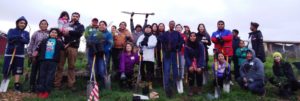
“CBO partnerships are especially important for an environmental organization like Friends of Trees because they help us effectively reach low income communities and communities of color, communities that are impacted first and the most by climate change.” -Surabhi Mahajan, Friends of Trees’ Equity, Diversity, and Inclusion Specialist
Trees + community is so much more than volunteers planting trees together. True community means that a diverse population has access to all of the benefits of trees, especially historically underserved communities of color. And in order to reach diverse communities we need a diverse range of partnerships.
Friends of Trees is fortunate to enjoy some amazing partnerships, and some particularly amazing partnerships are with Community Benefit Organizations (CBOs). CBOs are community-based nonprofit organizations, are often culturally specific, and provide some sort of community benefit. An example in Portland is Verde, which among other services provides workforce training for the Latinx community.
Friends of Trees’ CBO partners include Verde, Wisdom of the Elders, Black Parent Initiative, the Blueprint Foundation, APANO, and POIC. Most of these organizations are partners in our Urban Forestry Training Program*, which helps connect adults to jobs in the Urban Forestry field (learn more about this program here). Beyond this joint endeavor our CBO partnerships take a few forms:
Verde and Wisdom of the Elders each support our tree planting work through planting event preparation, participation, and follow-up, including post-planting tree care. Verde also provides some contractor services at our Portland office on NE MLK Jr. Blvd (get to know more about Wisdom in the next story).
Black Parent Initiative is a community-based organization that serves Black families or families with Black children through home care visits, economic job opportunities, and other services. The FOT-BPI partnership supports connecting Black families in Portland to nature and to tree planting events, as well as connecting to job training programs in the urban forestry and restoration sector.
The Grounding Waters program of the Blueprint Foundation exposes Black urban youth to careers in environmental science, and paid workforce training with Friends of Trees is part of the program. Grounding Water youth train and participate in planting events as Crew Leaders; Grounding Waters youth will also train and participate as Summer Inspectors, checking on the health of trees planted through our Neighborhood Trees Program, which will provide additional learning opportunities. * Note: The Blueprint Foundation is not a current partner in the Urban Forestry Training program, but is considering the program.
Our partnership with the Asian Pacific American Network of Oregon (APANO) focuses on the Jade Greening Project, which is working to increase the canopy of East Portland’s Jade District. Friends of Trees’ involvement includes tree-planting events and targeted community outreach toward getting more trees planted and volunteers engaged. A new feature of this partnership includes our first intern from APANO, whose focus has been supporting planting events through securing food donations from diverse neighborhood businesses and joining the planting teams.
Our partnership with Rosemary Anderson High School’s Portland Opportunity Industrialization Center (POIC) involves hands-on job training and leadership skill-building with high school students. Each season 10-14 POIC students train to be Crew Leaders and they participate in planning and leading Friends of Trees planting events; the students receive stipends as part of this program. Read more about this partnership in our December 2016 edition of Treemail.
Our CBO partnerships provide countless benefits, to both Friends of Trees and to our community. When youth are able to experience leadership positions, and when diverse communities have access to training that leads to internships and jobs with green organizations, preconceived barriers about green jobs and environmental engagement start to break down. Further, the youth interns can serve as role models for other youth volunteers, particularly for young people of color who can be inspired when someone who looks like them has a leadership role.
These partnerships also have an environmental justice aspect. Many of our partners and interns serve or live in under-canopied areas that experience greater impacts from climate change, such as heat islands. Involvement with community tree planting provides a way for participants to address some environmental inequities firsthand.
Equitable partnerships represent a core value of Friends of Trees and are critical to true community building, and we strive toward fostering this type of partnership in the work we do. We are thankful to the support of the City of Portland’s Bureau of Environmental Services and East Multnomah Soil and Water Conservation District for support that helps make these partnerships possible.
Pictured above: Urban Forestry Training Program participants from project partners POIC, APANO, Wisdom of the Elders, Verde, the Black Parent Initiative, and the Pathways to Farming program.
This story is from the January 2020 edition of our e-news, Treemail; check out other issues of Treemail here.
Get to know our partner: Chemawa Indian School
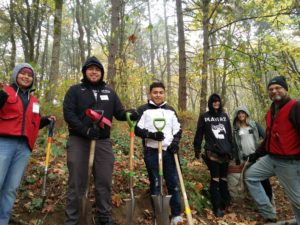
Friends of Trees has been partnering with Chemawa Indian School in Salem for more than five years. Our partnership includes training Chemawa students as Crew Leaders for our planting events in Salem and engaging hundreds of Chemawa students at tree planting and tree care events, including activities at the Chemawa Indian School campus.
This partnership has been driven by dedicated teachers and staff at Chemawa who are passionate about creating opportunities for the students to participate in their community through improving the environment while building their leadership skills.
Chemawa teacher Paula Stuart explains why the partnership is so valuable to Chemawa, “Friends of Trees’ offer to donate trees on Chemawa’s campus has increased awareness of the importance of environmental stewardship. Students who might not have otherwise noticed have joined in, sometimes merely tempted by donuts and hot chocolate, then catching the joy of working outside in teams of happy diggers.”
Paula continues, “Science teachers at the school have offered credit for participation and I am ever so happy that this active engagement has influenced several students’ interest in pursuing environmental careers.”
Finish reading here, where you will find the entire November edition of Treemail, our monthly e-news. Want to catch up on past issues of Treemail? They’re here!

